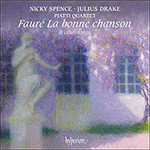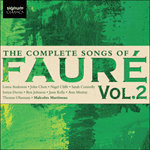The poem comes from Silvestre’s
Les ailes d’or (1880) in a sub-section entitled ‘Vers pour être chantés’. The song was composed before the poem’s appearance in book form. Fauré either found the poem in a newspaper or periodical, or was in touch with the poet himself. There are a large number or words (five wordy strophes) that trip off the tongue (if the singer is lucky enough to remember them), and all in a short space of time.
Notre amour is often heard as a breathless patter song—the whole performance geared to the singer’s final bars with the high note—like a musical firework ending with the blaze of a Catherine wheel. With this number of words to put across (most of them proclaiming thoughtful sincerity rather than dizzy excitement) performers should observe the composer’s
Allegretto, a marking that suggests a certain elan while avoiding a demented gabble. The tonal architecture has a subtle assymetry: the first and third strophes move from the tonic to G sharp minor and B major, the second from the tonic to F sharp minor and A major. For the fourth and fifth strophes the text suggests greater intimacy: the elegant sextuplets of the accompaniment are given deeper meaning by the affectionate counterpoint between the vocal line and an ascending five-finger scale in the pianist’s left hand (at bars 21 to 23, and 26 to 27). Between these two verses, at bar 25, there is a beautiful interlude, an arched rainbow of sound suspended in the right hand over the lapping of the tide in the left—a perfect illustration of the poem’s immediately preceding imagery. The brief detour into G major for the penultimate ‘chose éternelle’ adds strength to the clinching vocal cadence. The postlude betokens the colloquy of mutual affection: undulating triplets mesh with five-finger scales, an exchange between hands and staves that symbolizes the mingling of masculine and feminine.
from notes by Graham Johnson © 2005
La mélodie précéda la parution, en recueil, de ce poème extrait de
Les ailes d’or (1880) de Silvestre (très exactement d’une sous-section intitulée «Vers pour être chantés»), que Fauré découvrit dans un journal ou un périodique—à moins qu’il n’eût été en contact avec le poète. Il y a en un temps ramassé une profusion de mots (cinq strophes verbeuses) difficiles à prononcer (pour peu que le chanteur ait l’heur de s’en souvenir).
Notre amour est souvent interprétée comme une aria parlante, hors d’haleine—toute l’exécution est calculée en fonction des dernières mesures vocales, avec la note aiguë—, comme un feu d’artifice musical que couronne l’éclat d’un soleil. Avec tous ces mots à faire passer (qui, pour la plupart, disent une sincérité réfléchie plutôt qu’une excitation écervelée), les interprètes doivent observer l’indication de Fauré, cet
Allegretto qui suggère un certain élan, tout en se gardant d’un débit de paroles démentiel. L’architecture tonale présente une subtile asymétrie: les première et troisième strophes se meuvent de la tonique à sol dièse mineur et à si majeur, la deuxième passant, elle, de la tonique à fa dièse mineur et la majeur. Le texte des strophes 4 et 5 insinue une intimité accrue: les élégants sextolets de l’accompagnement voient leur signification renforcée par l’affectueux contrepoint entre la ligne vocale et une gamme ascendante (à cinq doigts) à la main gauche du pianiste (mesures 21–23 et 26–27). Entre ces deux strophes vient s’intercaler, à la mesure 25, un splendide interlude, arc-en-ciel sonore suspendu à la main droite par-dessus le clapot de la mer, à la main gauche—parfaite illustration de l’image qui vient juste avant, dans le poème. Le bref détour par sol majeur pour l’avant-dernier «chose éternelle» renforce la cadence vocale conclusive. Quant au postlude, il trahit une conversation empreinte d’affection mutuelle: des triolets ondoyants s’engrènent avec des gammes à cinq doigts, en un échange mains/portées qui symbolise la fusion masculin/féminin.
extrait des notes rédigées par Graham Johnson © 2005
Français: Hypérion
Das geradezu luftige
Notre amour fängt auf köstliche Weise die Darstellung der Liebe des Dichters als „leicht“ und „ewig“ ein.
aus dem Begleittext von Jessica Duchen © 2025
Deutsch: Viola Scheffel


 Fauré: La bonne chanson & other songs
Fauré: La bonne chanson & other songs Fauré: The Complete Songs, Vol. 2
Fauré: The Complete Songs, Vol. 2
